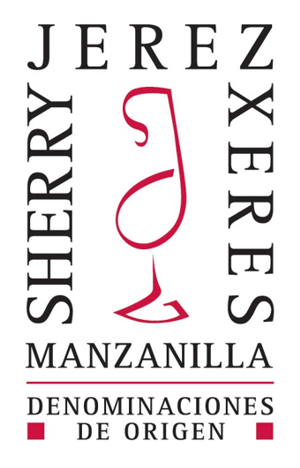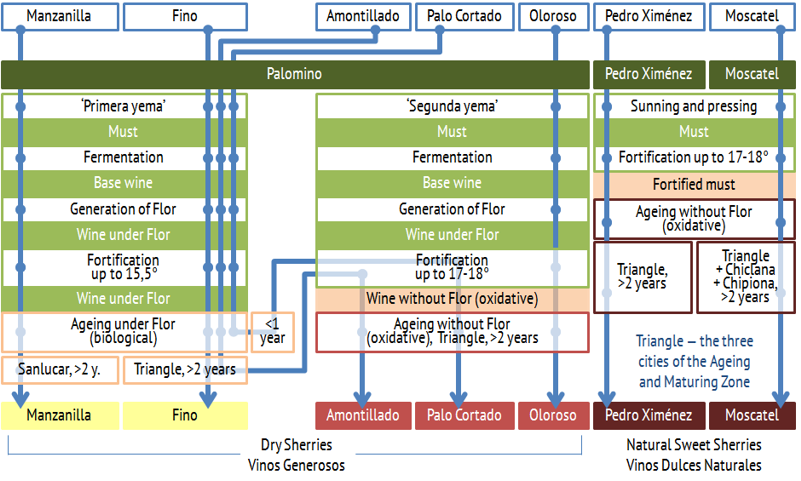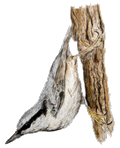
- Sherry Wine:
- Production
- Classification
- Cities & Bodegas
- Tastings
- Analogues
- Authors & Contacts
- Ðóññêèé ñàéò
Sherry Wine. General Information
Olga Nikandrova and Denis Shumakov.
Sherry (Jerez, Xeres) is a family of fortified wines produced in the Jerez zone (Andalucía, Spain) from Palomino, Pedro Ximénez and Moscatel grape varieties. The territory of its production, the requirements applied to the raw material and the basic set of vinification techniques are regulated and controlled within the framework of D.O. “Jerez — Xérès — Sherry” and D.O. “Manzanilla — Sanlúcar de Barrameda”.

Official “Jerez-Xérès-Sherry”
“Manzanilla-Sanlúcar de Barrameda”
D.O. mark
Varied primary product, several methods of processing it and the complex ageing and maturation system provide for the production of sherries with a very wide range of characteristics (from extraordinary dry and light to extremely rich and sweet) and of very different rates (from affordable mass-market products of sustained quality to exclusive wine with a high collector potential). Sherry production and consumption traditions are closely linked to the history and culture of Andalucía and its regular trade partners. Sherries’ bright terroir qualities make them a simple, clear and attractive theme for enotourism and an apposite souvenir. The taste variety of sherries ensures their high potential in food pairing and effectively blends them into absolutely different gastronomic and cultural traditions. The ethics and esthetics of the sherry consumption go far beyond the gastronomic boundaries and transform it from a drink with certain flavor characteristics into a beverage of a special mood and a characteristic lifestyle.
Sherries may be divided into three groups.
The first one — dry sherries (Vinos Generosos): Fino, Manzanilla, Palo Cortado, Amontillado and Oloroso.
The second group — natural sweet sherries (Vinos Dulces Naturales): Pedro Ximénez and Moscatel.
Every dry or natural sweet sherries are produced in its own way (where the grape variety or the location may be taken into consideration). These seven sherry kinds we’ll sometimes call the basic ones.
Finally, the third group — blended sherries (Vinos Generosos de Licor). To make them the two first groups are blended with one another or with some different components. They are Dry, Pale Cream, Medium and Cream.
This classification is not exhaustive — it ignores several derivative sherry types; besides the presence of some blended and even basic sherries is questioned from time to time, which, however, is not very important at the moment.
For a start it’s important to correctly identify the sherry by its label. A sherry label may contain a large amount of textual information. It may specify the manufacturer, brand name, special commercial name, city where this sherry was aged, grape variety and a lot of other (sometimes quite arbitrary) data.
In all this array of information first of all it is necessary to find one of key words from the following approximate list: Fino, Manzanilla, Palo Cortado, Amontillado, Oloroso, Pedro Ximénez (may be shortened to P.X.), Moscatel, Dry, Pale Cream, Medium or Cream. These words unmistakably mark the type of sherry — so it becomes clear what to with it (and on what grounds to base the search of information about it).
From the academic point of view, the basic sherries are much more interesting than the blends, therefore it would be more useful to begin acquaintance with sherries from the dry and natural sweet types. For example, with the help of this chart which creates an illusion of a cohesive and comprehensive approach to the issue. The word ‘triangle’ in it refers to the three cities of the Ageing and Maturing zone.

Application characteristics of the basic sherries may be easily compared in the table below.
Remember that alcohol abuse (and sherry — what a shame — is an alcoholic drink) is guaranteed to harm the health of the abuser and upset those in the vicinity. It is advisable not to exceed the dose of 1 ml per 1 kg of weight daily, i.e. a person weighing 80 kg should drink no more than 80 ml of sherry. Perhaps, a little more of Fino or Manzanilla, and less — of the sweet types of sherry.
Take care and know the measure. Have pleasant tastings!
Read next: The Jerez Region.
Warning!
This site can contain information about drinks excessive consumption of which may cause harm to health and is unadvisable for people who didn’t come of age.
Share Sherry
- Sherry.wine, FEDEJEREZ
- Copa Jerez, Sherry Week
- Sherry Notes, Jerez de Cine
- Los Generosos, Criadera
- Jerez-Xeres-Sherry
- Los Vinos de Jerez
Articles
- There are more articles in Russian than in English in this website. Sorry :(
Reviews
- To our great regret, we didn’t have time to translate tasting and traveling notes into English. But, if you want, you can see them in Russian.

